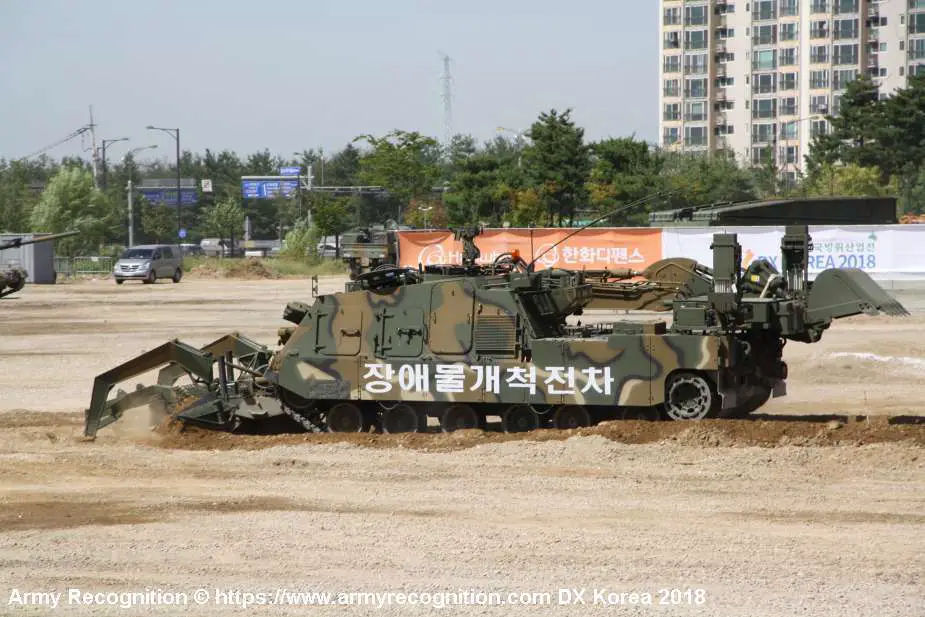According to an article from The Chosun Ilbo on September 18, 2023, South Korea has recently decided to provide two domestically-produced K600 "Rhino" combat engineer vehicles to Ukraine. This engineer vehicle is based on the K1A1 Main Battle Tank and is designed for obstacle clearance and mine removal, offering assistance to Ukraine in its ongoing struggle against landmines and hazardous obstacles. Although not classified as lethal weapons, these vehicles have the capability to breach enemy defense lines if necessary, making them significant military equipment provided by South Korea to Ukraine.
Follow Army Recognition on Google News at this link

The K600 Rhino mine-clearing tank is based on the K1A1 main battle tank (Picture source Army Recognition)
The K600 Rhino, known as "Kopruso" ("rhinoceros") within South Korea, is a combat engineer vehicle built on the chassis of the K1A1 main battle tank (MBT) and equipped with Pearson Engineering's Full Width Mine Plow mine trawl, engineering equipment, as well as a powerful magnetic field generator for neutralizing modern mines (SEMZ). Additionally, the machine boasts increased anti-mine protection.
It entered service in 2020 and is equipped with a diesel engine producing 1,200 horsepower, with a weight of 62 tons. While the K600 Rhino is not designed as lethal weaponry, it represents substantial combat-ready equipment delivered by South Korea to Ukraine.
The decision to dispatch two K600 Rhino combat engineer vehicles to Ukraine was prompted by Ukraine's urgent appeal for non-lethal aid, encompassing critical equipment for demining, transportation, medical services, and air defense. This appeal was presented during a recent meeting between Ukrainian President Volodymyr Zelenskyy and South Korean President Yoon Seok-yeol at the G7 summit.
President Yoon's commitment to support Ukraine was initially established during a summit meeting in Hiroshima at the G7 Summit in Japan. This commitment included the provision of non-lethal resources for demining activities and post-war reconstruction. During a subsequent visit to Ukraine in July, President Yoon reaffirmed his dedication to supplying landmine detectors and demining vehicles to address Ukraine's pressing needs.
The decision to provide these combat engineering vehicles was influenced by North Korean leader Kim Jong-un's visit to Russia, raising concerns about potential increases in Russian military support, including the supply of ammunition. Given these considerations, the South Korean government has encouraged Ukraine to restrict the use of the K600 Rhino for humanitarian purposes, particularly for mine clearance operations in rear areas.
Ukraine is currently confronted with a severe landmine crisis, with landmines deployed by the Russian military creating an extensive minefield covering an area of 250,000 square kilometers, exceeding the size of the entire Korean Peninsula (220,000 square kilometers).
The urgency of demining operations in Ukraine is rooted in the context of the Russian invasion that began in February 2022. A Globesec report from April 26, 2023, revealed that nearly 30% of Ukraine's territory, equivalent to approximately 174,000 square kilometers, is afflicted by landmines and unexploded ordnance. Demining efforts are intricate and resource-intensive, with the tactics employed by Russian forces further complicating the process. By June 2023, these efforts had resulted in the clearance of approximately 540,000 unexploded items. The World Bank estimates that the total cost of ensuring Ukraine's safety from these hazards amounts to a staggering $37 billion.
This contamination poses significant challenges, both in terms of resource allocation and economic stability, highlighting the critical role played by innovations like the domestically-produced Pozhmashina PM-B and the growing demand for existing mine-clearing vehicles, such as the Bozena-4, the Bozena-5, the Digger D-250, the Wisent 1, and now the K600 Rhino.
















